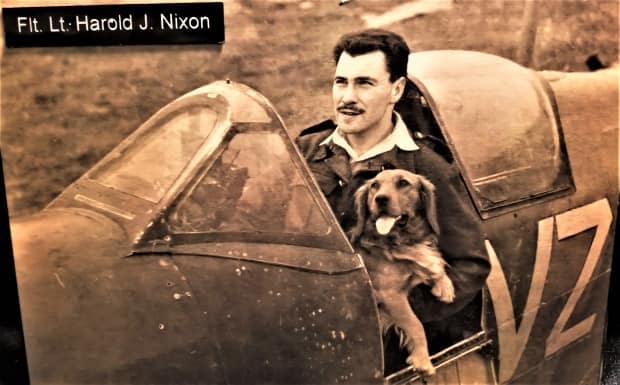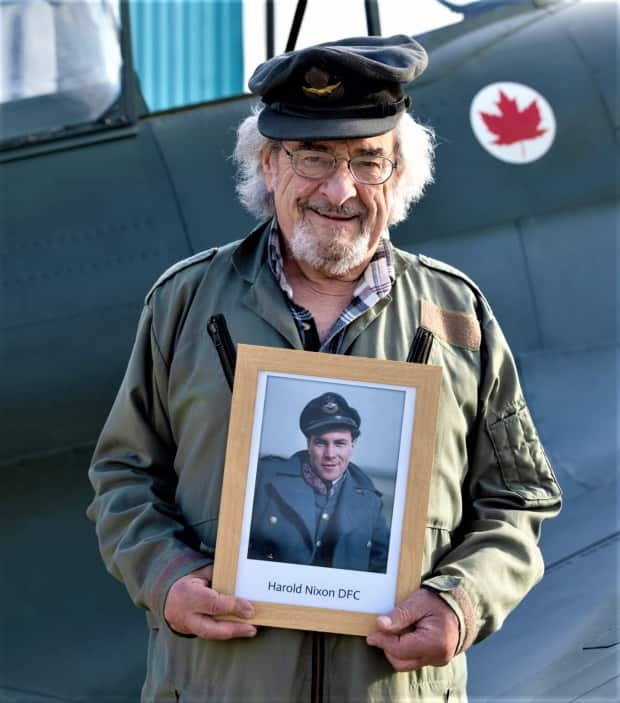Almost 80 years after WW II, Ancaster man takes 'thrill of a lifetime' flight in dad's plane

As a child, Wilson Nixon would sit at the top of the stairs of the family home and listen in on his father Harold's stories about his time as a Royal Canadian Air Force (RCAF) fighter pilot in the Second World War.
Wilson said his dad didn't talk much with him about the war, but he would occasionally tell guests about dog fights with German Messerschmitt plane pilots or his time stranded behind enemy lines.
Wilson, now 70, said the stories always stuck with him, but it wasn't until this October, when British watchmaker Colin Andrews sent him a Facebook message, that he learned more of his father's story and had an opportunity to fly in the Spitfire fighter plane his father once used in the war.
The history of Harold J. Nixon
Harold Joseph Nixon was born in Hamilton in 1919, went to Central Collegiate for high school and was studying engineering at McMaster University in 1941 when he signed up to fight with the RCAF.
Harold was flying a different fighter plane on July 27, 1944, when he was shot down by what was likely a German tank. A debriefing document Andrews discovered while writing a biography on Harold shows that he spent over a month behind enemy lines, trying to find his way back to Allied forces.
On Sept. 24, 1944, the Hamilton Spectator reported Harold had been missing but was by then "reported safe." Formerly classified documents show he made it back behind Allied lines on Sept. 1 of that year.
While he served in the RCAF, Harold flew the recovered Spitfire five times.

Another RCAF pilot flew the Spitfire 25 times more than Wilson's father, and was piloting the plane when it was shot down.
Andrews uncovered all of this while he was working on a biography about Harold, after he created a series of watches from scrap metal taken from the Spitfire.
"It's not just a bit of metal — it's a bit of metal that this is the story behind it," Andrews said.
"The Spitfire was operating from France when it got shot down. It was the 30th of July, 1944."
Andrews said that at that point, the German Luftwaffe, or air force, was "pretty much demolished," and pilots were looking for ground targets like trucks and houses to attack.

"It looks like somebody shot at the Spitfire, hit it under the wing," Andrews said, adding the radiator beneath the wing of the plane likely overheated and stopped the engine.
The plane wasn't recovered until the late 1980s.
"Partly it survived and wasn't recovered because of its location, because it was in a difficult-to-reach location, in a sort of marshy field," Andrews said.
The plane spent decades in different war museums before the Biggin Hill Heritage Hanger, a company specializing in Spitfire restorations, bought the plane and put it back in working condition.
The inaugural flight
Harold passed away in 1985, but Wilson had the chance to connect with his father in a way he never thought he would.
Andrews invited Wilson to England at the end of October, 2022 to take part in the inaugural flight of the refurbished Spitfire.
As part of the plane's christening, Wilson, along with the son and nephew of the plane's final pilot, Harold Kramer, flew in the Spitfire, with the help of a licensed pilot, and were able to take over the controls of the plane for a short period.

"They took me up in the plane for about half an hour and I was given basic instruction on different things, but main thing being that I was able to fly it for a short time, which was unbelievable," Wilson said.
"I mean, it was the thrill of a lifetime."
Wilson said that up in the plane, he could see nothing but empty sky around him. He pictured what it would be like, to feel so exposed to other enemy pilots, and thought of his dad sitting in the pilot seat.
"At one point, before I was flying it, I closed my eyes and I just pictured my father in front of me … flying the Spitfire.
"Just amazing."


